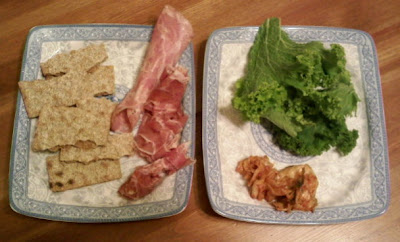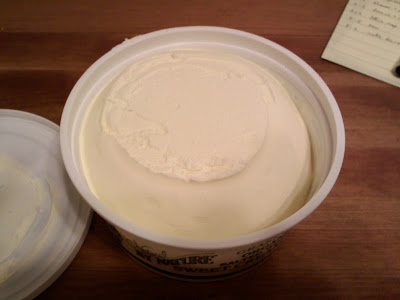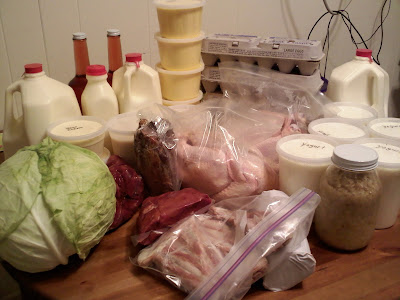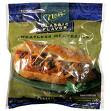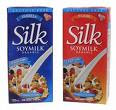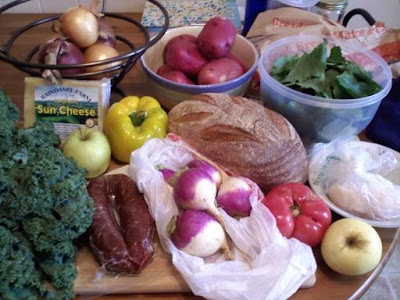
Oliver LOVES yogurt. In fact, he loves it so much that he will happily eat 4-8 oz. every day. Since each quart costs $4-5, when we factor in my own desire to eat yogurt regularly, plus the fact that now that he insists on feeding himself much of the yogurt ends up decorating his face or even his lap, the weekly price is getting up there with the cost of butter. I am willing to pay $10 a week for good butter, but not for yogurt!
After discussing home yogurt-making with several people, and feeling guilty about the $17 candy thermometer I purchased at Whole Foods way last year in the throes of yogurt-making ambition, I finally decided to just take the plunge. I made sure I had some extra raw milk on hand and followed the fairly easy instructions. However, I messed up and the yogurt came out tasting mild and good, but with an unpleasant mucousy consistency. Oliver ate it without complaint, but I was pretty sure I could do better.
Last night, armed with 2 gallons of fresh raw milk, I decided to give it another try. This time: complete success! And at $1.73 (the price of 4 cups of raw milk) this quart is quite a bargain. Hurrah!
Here's how:
To make one quart, you will need:
-4 cups whole milk (preferably raw and unhomogenized -- NEVER ultra-pasteurized! However, if all you can buy is pasteurized milk, making it into yogurt will help restore some of the beneficial properties lost during pasteurization.)
-1/4 cup high-quality plain full-fat yogurt for starter (I used Seven Stars plain which is the best kind available in stores, but you could also use another brand, or even the yogurt starter culture which is available in freeze-dried form.)
-ceramic or glass bowl
-candy thermometer
-a warm place to keep the milk around 95-105 degrees
First, heat the milk in a saucepan until it reaches approximately 110-120 degrees. It's okay if it gets hotter; my mother has even had milk boil and then turn into yogurt just fine, and sometimes I lose track of time and it reaches the point where it begins to form a skin. But if you are using raw milk and you want to preserve all the "raw" qualities, try to catch it when it's still relatively cool (if using pasteurized, it should be heated to 185).

Next, let it cool to around 100-105 degrees. You can remove the pot lid and cool it in the refrigerator for a little while if it's very hot. If the milk has gotten warm enough to form a skin, these may keep forming on top while it's cooling, so you may want to remove them before adding the yogurt so that there is no unnecessary extra thickening.
Then, pour the milk into the bowl and add the 1/4 cup yogurt to serve as a starter. Mix this together very thoroughly. (I made the mistake of adding the yogurt to the hot milk, which killed the bugs the first time around. Don't do this -- wait til it's cool.)
Next, wrap the bowl in a blanket or sweater and put it in a warm place. This could be one of the following scenarios:
-in an oven with a pilot light,
-in an oven with a light bulb (light on) and a warming stone (first heat the oven so the warming stone gets warm, then turn it off),
-over an electric burner set on the lowest possible setting (this worked for my mother),
-on top of a heater,
-or (as I did) over the rear right burner of a stove with the oven set to 200-250 degrees (this will work as long as the heat from the stove comes up through this burner -- you should know which burner it is on your particular model, though I think this may be gas stoves only). I finally found the perfect use for the tea cozy my mother brought me from Scotland, and filled in the gaps at the bottom with dish towels.

Don't obsess over the exact temperature. I was told it had to stay at 105 degrees and was pulling my hair out the first time trying to get things just right. Even with this final set-up, I could only manage about 95 degrees or maybe a little more, but it worked JUST FINE. Just get your milk and yogurt starter to around 100 degrees, find a warm spot, wrap the bowl warmly, and leave it alone for several hours. (If you are concerned it isn't remaining at the correct temperature, feel free to go in and test it with the thermometer, then adjust the location or setup accordingly.)
I left the milk overnight (about 7 hours) and by morning we had this:

Absolutely delicious, thick yogurt with a pleasing custard-like consistency. The added boon: the taste is extremely mild with just the right hint of tartness. (The yellow layer on top is the final milk skin, which can be mixed in or removed with a spoon.)
Don't be discouraged if the first batch doesn't come out perfectly; chances are it will still be quite edible. Once you find the way that works in your home, with your equipment and available warm spots, you will be able to repeat these steps and get the same results every time. Final note: if the yogurt seems a bit liquidy, never fear -- it will firm up in the fridge. And PLEASE, if it gets too hot and separates, don't throw it away! Simply strain the curds from the whey, let the curds drain well and dry out a little, then season with herbs and sea salt, or make a sweet cheese with honey and walnuts. Directions forthcoming!
As for cost savings, it breaks down like this:
If I bought 2 quarts weekly (which is how much we can eat easily):
$4/qt x 8 qts = $32 monthly
$4.80 delivery charge (15%)
__________
$36.80 (what we were spending before on yogurt)
I will now be spending the following:
$6/gallon x 2 gal = $12 monthly
$1.80 delivery charge (15%)
__________
$13.80 (monthly expenses for buying the milk to make yogurt)
This makes a total savings of $23! Plus we will not be using and wasting plastic containers all the time, which makes me very happy. :)




